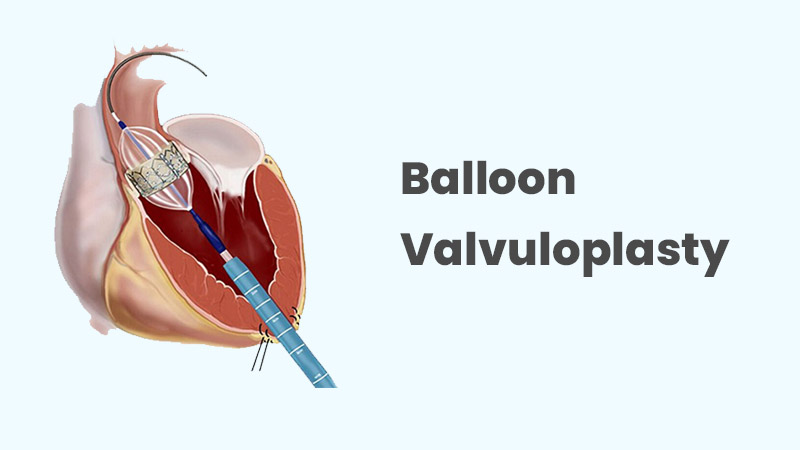List of Top Balloon Valvuloplasty doctors near by
Talk to our doctors
Balloon Valvuloplasty

A narrowed heart valve can make it challenging to pump blood effectively throughout your body. This can lead to complications such as heart failure, blood clots, or stroke. Balloon valvuloplasty is a procedure that can help alleviate this condition. Balloon valvuloplasty offers a minimally invasive procedure to open narrowed heart valves, restoring proper blood flow and improving heart function.
Understanding Balloon Valvuloplasty
Balloon valvuloplasty is a catheter-based procedure used to widen narrowed heart valves. It's most commonly used for treating stenosis of the aortic valve (aortic valve stenosis) and the mitral valve (mitral valve stenosis). During the procedure, a thin, flexible tube called a catheter is inserted into a blood vessel in the groin or arm. The catheter is then guided to the narrowed valve using X-ray imaging. Once positioned, a small balloon at the tip of the catheter is inflated, pushing against the narrowed valve leaflets and stretching them open to improve blood flow.
Types of Balloon Valvuloplasty
- Balloon Aortic Valvuloplasty: The balloon aortic valvuloplasty procedure is used to treat aortic valve stenosis, a condition characterized by narrowing of the valve opening between the heart's left ventricle and the aorta.
- Mitral Valve Balloon Valvuloplasty: Mitral valve balloon valvuloplasty is performed to treat mitral valve stenosis, which occurs when the valve between the heart's left atrium and left ventricle narrows, restricting blood flow.
Who Needs Balloon Valvuloplasty?
Balloon valvuloplasty is typically considered for individuals experiencing symptoms of heart valve stenosis, such as:
- Shortness of breath: This can occur with exertion or even while at rest.
- Fatigue: Experiencing unusual tiredness and a lack of energy.
- Chest pain: Angina (chest discomfort) can occur with exertion.
- Palpitations: Experiencing a fluttering or rapid beating of the heart in the chest.
- Swollen ankles: Fluid buildup in the legs due to impaired heart function.
The Balloon Valvuloplasty Procedure
Balloon valvuloplasty is typically performed in a specialized cardiac catheterization laboratory within a hospital setting. Here's a breakdown of the process:
- Pre-operative Evaluation: A thorough evaluation by a qualified balloon valvuloplasty doctor is crucial. This involves discussing your medical history, symptoms, and medications. The doctor will perform a physical examination and order tests like echocardiograms (ultrasound imaging of the heart) to assess the severity of the valve stenosis and determine if balloon valvuloplasty is the most suitable treatment option.
- Preparation: On the day of the procedure, you will likely be instructed to avoid eating or drinking for several hours beforehand. Medications might be prescribed to help you relax during the procedure.
- The Balloon Valvuloplasty Procedure: The doctor inserts a catheter into a blood vessel in your groin or arm. The catheter is guided to the narrowed heart valve using X-ray imaging. The balloon at the catheter tip is then inflated to widen the valve. In some cases, additional procedures might be necessary depending on the specific situation. The procedure usually completes in one to two hours.
- Recovery: After the procedure, there will be a monitoring period of a few hours to check the blood flow and functionality of the valve that was treated. Balloon valvuloplasty recovery time is generally quicker compared to open-heart surgery, with most patients going home within a day or two.
Living After Balloon Valvuloplasty
While balloon valvuloplasty successfully opens narrowed valves, long-term management is crucial. Here's what to expect:
- Medication Management: Your doctor might prescribe medications to manage blood pressure, heart rhythm, or prevent blood clots.
- Regular Follow-up Appointments: Regular visits with your cardiologist are essential to monitor the valve function and potentially determine the need for future interventions.
- Healthy Lifestyle Choices: Maintaining a healthy diet, engaging in regular exercise (as approved by your doctor), and managing stress can significantly contribute to your overall cardiovascular health.
Balloon valvuloplasty offers a valuable minimally invasive option for individuals with narrowed heart valves. By widening the valve opening and improving blood flow, this procedure can significantly alleviate symptoms and improve heart function. However, it's important to remember that balloon valvuloplasty might not be a permanent solution, and the valve may narrow again over time. Working closely with your nearest heart specialist, adhering to a healthy lifestyle, and attending regular follow-up appointments are crucial for managing your heart health and maintaining optimal outcomes in the long run.
FAQ'S
It treats narrowed heart valves (stenosis) by widening the valve opening to improve blood flow.
The procedure typically lasts about 1-2 hours, depending on the complexity of the condition.
While it provides significant relief, the valve may narrow again over time, requiring further treatment.
Yes, it is usually performed under local anesthesia with sedation to keep the patient comfortable.
Most patients recover within a few days but may need a week of rest before resuming normal activities.
Yes, it is often recommended for both younger and older patients with valve narrowing issues, depending on individual health needs.
Many patients feel relief from symptoms like breathlessness and fatigue within a few days after the procedure.
Related Blogs
Patient Reviews & FeedBack
© 2025 Kailash Healthcare Ltd. All Rights Reserved





 D. S. GambhirKailash Hospital, Noida.jpg)





.jpg.jpg)










